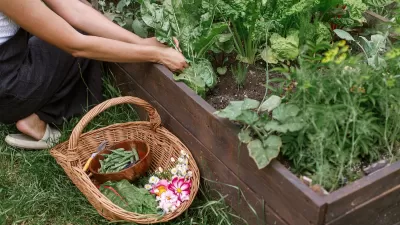Pulling in community members and a network of local nonprofits, Phoenix's "Spaces of Opportunity" is an attempt to make urban farming something more than a catchphrase.

The dream is to make local produce available in a suburban food desert. As for the implementation, we'll have to see. For its urban farming project in Phoenix, called "Spaces of Opportunity," DSGN AGNC used a hybrid design approach: bottom-up as well as top-down. Sam Lubell writes, "the firm comes up with a plan, but then the community inevitably changes it to better meet their needs, and then the designers scramble to catch up with an adjusted plan."
The overall plan involves taking a parcel of land and laying out "segmented plots for community gardens and incubator farms. Master farmers will teach apprentices agrarian skills, helping them progress so they can get their own plots to work." Local nonprofits, philanthropists, and community members are actively honing the design, which has broadened to include multiple community-focused uses.
And that's probably a good thing. "Incorporating so many types of uses has helped not only with interest, but also with fundraising." With construction currently underway, DSGN AGNC principal Quilian Riano hopes this model will help urban farming take off in earnest.
FULL STORY: Urban farming in suburban Phoenix becomes the basis for an entire community hub

Trump Administration Could Effectively End Housing Voucher Program
Federal officials are eyeing major cuts to the Section 8 program that helps millions of low-income households pay rent.

Planetizen Federal Action Tracker
A weekly monitor of how Trump’s orders and actions are impacting planners and planning in America.

Ken Jennings Launches Transit Web Series
The Jeopardy champ wants you to ride public transit.

New Mexico Aging Department Commits to Helping Seniors Age ‘In Place’ and ‘Autonomously’ in New Draft Plan
As New Mexico’s population of seniors continues to grow, the state’s aging department is proposing expanded initiatives to help seniors maintain their autonomy while also supporting family caregivers.

USDOT Waters Down Self-Driving Car Regulations
The agency is reducing reporting requirements for autonomous vehicles and cars with self-driving features, prompting concern among safety advocates who say transparency is essential to the safe deployment of AV technology.

‘Minnesota Nice’ Isn’t so Nice When You Can’t Find a Place to Live
The Economic Development and Housing Challenge Program can help address the scourge of homelessness among Indigenous people.
Urban Design for Planners 1: Software Tools
This six-course series explores essential urban design concepts using open source software and equips planners with the tools they need to participate fully in the urban design process.
Planning for Universal Design
Learn the tools for implementing Universal Design in planning regulations.
Heyer Gruel & Associates PA
Ada County Highway District
Institute for Housing and Urban Development Studies (IHS)
City of Grandview
Harvard GSD Executive Education
Toledo-Lucas County Plan Commissions
Salt Lake City
NYU Wagner Graduate School of Public Service



























